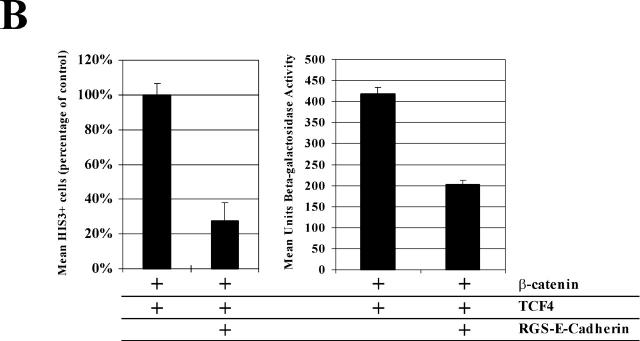Figure 4.
The cytoplasmic domain of E-cad inhibits β-cat/TCF4 transcriptional activity in yeast by sequestration in the cytoplasm. (A, left) Cells induced to express β-cat and TCF4 (A–C and G–I) or β-cat, TCF4, and RGS–E-cad (D–F and J–L) from plasmids were subjected to IF with an antibody against β-cat (A and D) or E-cad (G and J). Proteins (A, D, G, and J), DNA (B, E, H, and K), and cells (C, F, I, and L) were photographed. (A, right) Total cell extracts (Total) or β-cat immunoprecipitates (β-cat IP) from cells expressing β-cat and TCF4 plasmids plus either control plasmid (C) or RGS–E-cad (E) were analyzed by Western blot with antibodies against β-cat (top), the FLAG epitope tag (to detect TCF4; middle), or E-cad (to detect RGS-E-cad; bottom). (B, left) HIS− cells induced to express β-cat and TCF4 or β-cat, TCF4, and RGS–E-cad from plasmids along with the 5X LEF HIS3 reporter were plated under stringent HIS3 selection conditions, and the number of surviving colonies were quantitated. (B, right) Cells induced to express β-cat and TCF4 or β-cat, TCF4, and RGS–E-cad from plasmids along with the 5X LEF LacZ reporter were assayed for β-gal activity.



